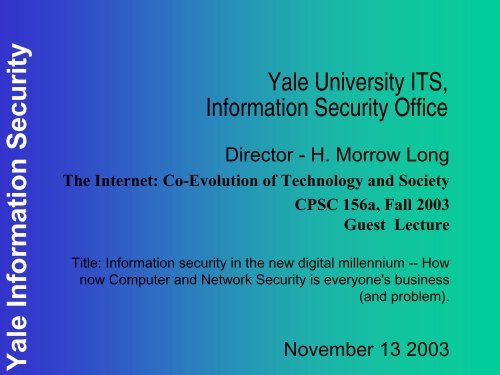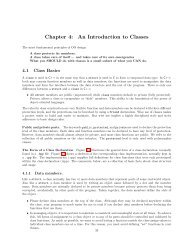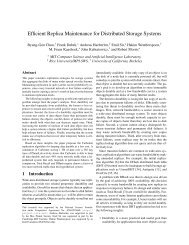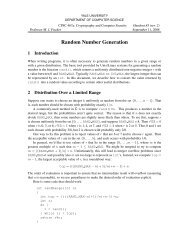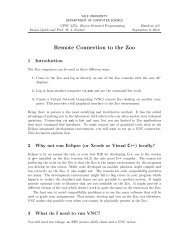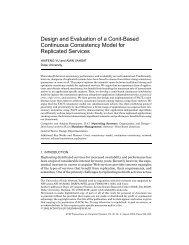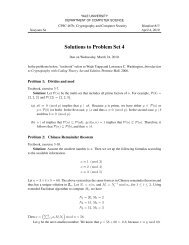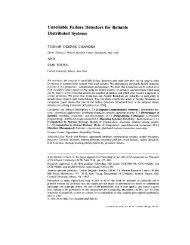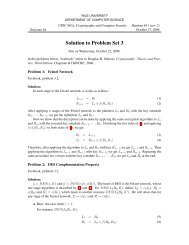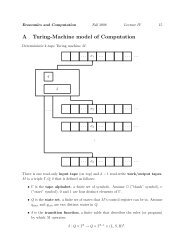Yale University ITS Information Security Office - Zoo - Yale University
Yale University ITS Information Security Office - Zoo - Yale University
Yale University ITS Information Security Office - Zoo - Yale University
- No tags were found...
You also want an ePaper? Increase the reach of your titles
YUMPU automatically turns print PDFs into web optimized ePapers that Google loves.
<strong>Yale</strong> <strong>Information</strong> <strong>Security</strong><strong>Yale</strong> <strong>University</strong> <strong>ITS</strong>,<strong>Information</strong> <strong>Security</strong> <strong>Office</strong>Director - H. Morrow LongThe Internet: Co-Evolution of Technology and SocietyCPSC 156a, Fall 2003Guest LectureTitle: <strong>Information</strong> security in the new digital millennium -- Hownow Computer and Network <strong>Security</strong> is everyone's business(and problem).November 13 2003
<strong>Yale</strong> <strong>Information</strong> <strong>Security</strong><strong>Yale</strong> <strong>Information</strong> <strong>Security</strong> Committee<strong>Yale</strong>CERT(Computer Emergency Response Team)<strong>ITS</strong> INFORMATION SECURITY OFFICEEstablishmentMission/CharterFIRST YEARIncidentsInitiativesPlans
<strong>Yale</strong> <strong>Information</strong> <strong>Security</strong><strong>Yale</strong> <strong>University</strong>, IT Advisory Cmte,<strong>Information</strong> <strong>Security</strong> SubCommitteeNon-<strong>ITS</strong>CommitteeMembersRobert McNeilDirector of <strong>University</strong> AuditingJohn MayesDirector of ProcurementRotating PositionAssociate ProvostSusan SawyerDeputy General Counsel<strong>Office</strong> of General CounselStacy RuweExecutive DirectorFinancial OperationsSchool of Medicine<strong>ITS</strong> <strong>Information</strong><strong>Security</strong> <strong>Office</strong>H. Morrow LongDirector and CISOAllison MacFarlanAcademic ISOJim HackettAdministrative Systems ISO<strong>ITS</strong>Committee MembersPhilip E. Long<strong>University</strong> Director of <strong>Information</strong>TechnologyCharles PowellDirector of Academic ComputingIndy CrowleyDirector of Administrative SystemsAndrew NewmanDirector of Technology & PlanningJoseph P. PaolilloAssociate Director ofData Network OperationsDavid StaggDirector of InfoSecSchool of Medicine, <strong>ITS</strong>
• Formal Title: Director of <strong>Information</strong> <strong>Security</strong>,DMCA N Agent, CS Fac, He who delivers bad news,Official Interpreter of IT policy, gentle introducer to DMCAand Copyright issues to Frosh at Orientation.• Private Institution where Bill met Hillary, dubya was a fratboy.• In house counsel (20 person office, we get sued a lot!)• Keeping our students from being sued by the RIAA. Atone point I was tasked with finding someone to pay (off).<strong>Yale</strong> <strong>Information</strong> <strong>Security</strong> H. Morrow Long,“<strong>Yale</strong> <strong>University</strong>”,
<strong>Yale</strong> <strong>Information</strong> <strong>Security</strong>
<strong>Yale</strong> <strong>Information</strong> <strong>Security</strong>
<strong>Yale</strong> <strong>Information</strong> <strong>Security</strong>
<strong>Yale</strong> <strong>Information</strong> <strong>Security</strong>
www.yale.edu/its/security<strong>Security</strong>@yale.edu<strong>Yale</strong> <strong>Information</strong> <strong>Security</strong>
<strong>Yale</strong> <strong>Information</strong> <strong>Security</strong>
<strong>Yale</strong> <strong>Information</strong> <strong>Security</strong>
<strong>Yale</strong> <strong>Information</strong> <strong>Security</strong><strong>Yale</strong>CERT (<strong>Yale</strong> Computer EmergencyResponse Team)<strong>ITS</strong>-Admin Sys<strong>ITS</strong> Support(DSPs)<strong>ITS</strong> Systems (SAs)<strong>ITS</strong> Data NetworkOperations (DNO)Joseph P. PaolilloAssociate DirectorCraig CarterCisco Network Engr.John GreenwaldAsst. Cisco Network Engr.<strong>Yale</strong> Network UsersH. Morrow Long<strong>ITS</strong><strong>Information</strong> <strong>Security</strong><strong>Office</strong><strong>ITS</strong> AcademicComputing &Technology PlanningComputing Assistants (CAs)UndergraduatesFaculty Support ProgramFSPsInstitution Web and EmailTeamsRichard Morris<strong>University</strong> E-Postmaster<strong>Yale</strong> WebMastersInfo Sec Cmte<strong>Yale</strong> Police<strong>Yale</strong> LibraryOther depts<strong>ITS</strong> - MedUS CERTDavid StaggDirector of InfoSecTechnology OperationsSchool of MedicineRichard BeebeData Network OperationsTechnology OperationsSchool of MedicineYSM/Hospital
<strong>Yale</strong> <strong>Information</strong> <strong>Security</strong>Establishment/HistoryPre-1995199519971998Coopers & Lybrand &<strong>Yale</strong> AuditingAudit RecommendationDecemberPosition PostedJuneISO Hired.Plans, PoliciesFormalization.<strong>Yale</strong>’s external auditors(C &L ) recommendedestablishing a <strong>Yale</strong><strong>Information</strong> <strong>Security</strong><strong>Office</strong>r in yearly audits.<strong>Yale</strong> posts an <strong>Information</strong><strong>Security</strong> <strong>Office</strong>r position.<strong>Yale</strong> hires its first<strong>Information</strong> <strong>Security</strong><strong>Office</strong>r.Define formal structureand Mission for <strong>Yale</strong><strong>Information</strong> <strong>Security</strong><strong>Office</strong>.<strong>Yale</strong>’s internal auditorsrecommendedestablishing a <strong>Yale</strong><strong>Information</strong> <strong>Security</strong><strong>Office</strong>r in yearly audits.<strong>Yale</strong> interviews<strong>Information</strong> <strong>Security</strong><strong>Office</strong>r positioncandidates through theyear in 1996.<strong>Yale</strong> <strong>Information</strong> <strong>Security</strong>(Policy & Steering)Committee founded insummer of 1997.Official charter for <strong>Yale</strong><strong>Information</strong> <strong>Security</strong>Committee.
<strong>Yale</strong> <strong>Information</strong> <strong>Security</strong>Mission /CharterMISSIONCHARTERStatementPointsTo support the goals of the<strong>Yale</strong> enterprise by assuringthe availability, integrity andconfidentiality of information.Policies, Standards and Practices.• Propose, Advise, Coordinate, Write.Assurance and Monitoring• Auditing, Testing, Support, Detection.Investigation and Enforcement• Incident Handling and Tracking.Awareness and Education• Communication and Training.
Major Incidents<strong>Yale</strong> <strong>Information</strong> <strong>Security</strong>INTRUSIONS• Departmental Linux PCs - Summer 1997• <strong>Yale</strong> Library Web Server Intrusion - Sept. 97• <strong>ITS</strong> ACS Pantheon “Minerva” Break-In Oct. 97DENIAL OF SERVICE ATTACKS• “SMURF” network broadcast bounce packet flood - Spring97 through Jan 1998.• “Pepsi” floods via departmental Linux PCs and Pantheonaccounts -- Summer and September 1997.• “SPAM” relaying via <strong>Yale</strong>VM, <strong>ITS</strong> and CS E-Mail servers(Unsolicited Bulk/Commercial E-Mail). 1997-8.USER ACCOUNTS COMPROMISED• <strong>ITS</strong> ACS Pantheon “Minerva” Break-In Oct. 97• Network Sniffing Reported Nov 97 - Jan 1998.
<strong>Yale</strong> <strong>Information</strong> <strong>Security</strong><strong>Yale</strong> InfoSec Incidents• Sniffing• Spoofing• Spamming• Flooding• E-Mail forgery, harassment, etc.• Web based identity theft.• Intrusions (Unix and Linux computers)• Account compromises (telnet, POP)• Viruses• Copyright, Software license infringement
and Creeping Death Music VS. <strong>Yale</strong>, et.alhttp://www.metallica.com/metdotcom/help/copyright_trademark.html<strong>Yale</strong> <strong>Information</strong> <strong>Security</strong>
<strong>Yale</strong> <strong>Information</strong> <strong>Security</strong>
<strong>Yale</strong> <strong>Information</strong> <strong>Security</strong><strong>ITS</strong> AcademicComputing System(ACS) Pantheon<strong>ITS</strong> ACS Aleks Margan notices break-in.Aleks pages the Univ. ISO via beeper.• We investigate.• We assess damage.• We determine onlyone machine affected.We shut down Minerva and swap in a freshlyinstalled “hot spare” machine as Minerva.• We meet with <strong>ITS</strong> TP& ACS directors.• We decide to shut theBanner student Web.We shut down the “Banner” studentinformation system Web interface.• Users logging in onthe Pantheon & <strong>Yale</strong>Web server areprompted to changetheir password.Incident HandlingAnatomy of an incident“Minerva” October 14 1997 “Break-In”• We plan shutdown andswap with fresh “hotspare” system.• We contact <strong>ITS</strong> Dir.• We decide to force apassword change.• We prepare a statement.• We force students whologin to change theirpasswords in two weeks.• Other users (E-Mail) aregiven a grace period.ISO dissects attack during the night of 10/14-15.Prepares CERT & <strong>Yale</strong>CERT reports.• Minerva infosec audit.• Evidence of intrudersessions (w/accounts &programs and source ofattacks) found in logs.Pantheon <strong>Security</strong> Review and Prevention Steps• Solaris OS patchprocedure audited &reviewed.Follow Through Actions• <strong>Yale</strong> Police notified.They contact FBI.• Other Internet sites &<strong>Yale</strong> admins notified.• Offending network’s IPaddress blocked.Aftermath• Log files secured.• Press releases to andinterviews with <strong>Yale</strong>Daily News and <strong>Yale</strong>Herald.•Tripwire softwarespecified and installedon Pantheon systems.• Banner studentsystem re-enabled.• Pantheon Kerberizedlogin and E-Mail accessto be promoted in 1998(encrypted auth & data).
<strong>Yale</strong> <strong>Information</strong> <strong>Security</strong>AInitiativesAdministrativeSystemsProject X <strong>Security</strong> DesignFirewall Access to Serversfrom Intra- & InternetNon-Project X <strong>Security</strong> Design• YHP & YSM IDX• TelecomSecure Access to Serversby Staff and VendorsServer <strong>Security</strong> Standards• Physical• Hardware• Software• OS• App EncryptBusiness Continuity Planningand AuditingStd Policies & Procedures• PasswordBAcademic Systemsand Data NetworkInternet Border & PhysicalIntranet <strong>Security</strong>Increase <strong>Security</strong> Awareness• E-Mail• NetworkSecure Access to Systemsby Staff and UsersServer <strong>Security</strong> Standards• Physical• Hardware• Software• OS• App EncryptBusiness Continuity Planningand AuditingStd Policies & Procedures• PasswordRanked by PriorityCDesktops & DeptsCampus-wideIncrease <strong>Security</strong> Awareness• E-Mail• NetworkSecure Access to Systemsby Staff and UsersServer <strong>Security</strong> Standards• Physical• Hardware• Software• OS• App EncryptBusiness Continuity Planningand AuditingStd Policies & Procedures• Password
<strong>Yale</strong> <strong>Information</strong> <strong>Security</strong>PlansSecure E-MailInfrastructureE-Commerce & EDI<strong>Security</strong> Policies andProceduresDefine Internet andRemoteAccess <strong>Security</strong>Policies andProceduresContinue to Increase<strong>Security</strong> Awarenessat <strong>Yale</strong> ThroughCommunication andTrainingInvestigate andImplement NT &Kerberos 5 SSOInstall Project X / <strong>ITS</strong>-ASsecure subnet FirewallSecure existing Non-Project X <strong>ITS</strong>/AS C/SSystemsBusinessContinuityPlanSecure <strong>Yale</strong>PhysicalDesktops andNetworks1 YearStrong Authentication for <strong>ITS</strong>Staff, Consultants & VendorsEncrypted Network AccessTo <strong>ITS</strong> Machines and E-Mail.Plan Project X / OracleApplications <strong>Security</strong>Create <strong>ITS</strong> Server<strong>Security</strong> Standards<strong>Yale</strong> PasswordPolicyTest and Audit Project XApplication Deployment6 MonthsImmediateSecure Accessto Academic &AdministrativeServers
<strong>Yale</strong> <strong>Information</strong> <strong>Security</strong><strong>Information</strong> <strong>Security</strong> At <strong>Yale</strong><strong>Information</strong> <strong>Security</strong> is responsible for:– Network monitoring with regard to security (scanning, flow monitoring).– Investigations: compromise, harassment, denial of service attacks, forensics.– Providing information about vulnerabilities, patches, viruses and worms.– PIX firewall configuration and management.– Content switch management.– <strong>Yale</strong> community <strong>Information</strong> <strong>Security</strong> education.– Enterprise security tools management: PGP, Norton Anti-Virus.– <strong>Security</strong> Architecture evaluation and enhancement.– <strong>Security</strong> policy development.– Certificates (Verisign, <strong>Yale</strong> self-signed web and identity certificates).– DMCA complaint processing and forwarding.– Departmental/HIPAA/GLBA security audits and risk analysis.
<strong>Yale</strong> <strong>Information</strong> <strong>Security</strong><strong>Information</strong> <strong>Security</strong> At <strong>Yale</strong>How we know what’s up:• We analyze our snort and firewall logs every day.• We can see all the DNO monitoring tools and we can look attraffic to specific machines or ports at our “front” connections.• We scan the enterprise for vulnerabilities.• We get complaints from other institutions about attacks from<strong>Yale</strong> student machines.• Students and staff call us when they notice something weird.• We get DMCA complaints, warrants and subpoenas.• The Police/FBI give us a call.
<strong>Yale</strong> <strong>Information</strong> <strong>Security</strong>Outline• Introduction -- <strong>Yale</strong> <strong>Information</strong> <strong>Security</strong>• Background on <strong>Yale</strong> <strong>University</strong>, IT ANDComputing Environments• Key Issues, Axioms and “Lessons Learned”• Rollout Issues• Real World (<strong>Yale</strong>) <strong>Security</strong> Case Studies• Conclusion
<strong>Yale</strong> <strong>Information</strong> <strong>Security</strong>Background on <strong>Yale</strong> <strong>University</strong>• 20,000 NetIDs (<strong>Yale</strong> Kerberos/NT Accounts)• 10,000 students (5,000 undergrad)• 10,000 employees (faculty and staff)• $7.2 billion endowment due to alumni andshrewd investments ($3.5 billion in 1994).• 200+ buildings.• Medical school is 40% and self-sufficient.• Major employer in City of New Haven.
<strong>Yale</strong> Univ. Net/Computing Environ<strong>Yale</strong> <strong>Information</strong> <strong>Security</strong>• 16,000+ IP addresses, 300+ Web servers• 2 Public Class B networks (128.36, 130.132) andseveral Class C networks.• 350+ subnets (300 10 mbits, 50 100 mbits)• 100 mbit switched/routed backbone -> gbit Enet• 10 megabit/second commercial Internet(TCG/Cerfnet). Soon to be 15 mbits/sec.• 45 megabit/second Internet2 via vBNS(to be 155 megabits/second via Qwest)• Used to be heavily Macintosh, now heavily WindowsNT on administrative desktops.
<strong>Yale</strong> <strong>Information</strong> <strong>Security</strong>Background on <strong>Yale</strong> <strong>University</strong>IT Organization (<strong>ITS</strong>)• 350+ Employees• 24x7 Professional Production environment(Administrative, E-Mail, Web, etc.)• Legacy Mainframe transition to “client/serverrightsizing Y2K business-re-engineering” BigBang : Project XNew Oracle Financials and Data Warehouse– AP/PO, GA/GL, HR/LD, Data Mart/Mining• SCT Banner, Telecom, IDX, MPAC
<strong>Yale</strong> <strong>University</strong> IT Org (<strong>ITS</strong>)<strong>Yale</strong> <strong>Information</strong> <strong>Security</strong>• <strong>ITS</strong> Director Phil Long– Univ. <strong>Information</strong> <strong>Security</strong> <strong>Office</strong>r and <strong>Office</strong>– Administrative Systems– Academic Media and Tech (formerly ACS)• includes A/V, Language Labs, etc.– Data Network Operations– RIS (merged Repro and Printing)– Support• Desktop, Help Desk, Store, Training, User Accounts– Technology and Planning– Telecom (includes CATV)
<strong>Yale</strong> <strong>Information</strong> <strong>Security</strong><strong>Yale</strong> <strong>University</strong> IT Org (<strong>ITS</strong>)• Almost all <strong>ITS</strong> subunits are standalonecharge-back units (but not <strong>Information</strong><strong>Security</strong>)• All students are charged a yearly $200 for:– 10 megabit Ethernet jack in dorm room– Phone in room.– CATV in room.• Most faculty and staff have a Windows NT PC(Pentium 200, 64MB RAM) on 10BaseT.Approx $16 to $25 monthly.
<strong>Yale</strong> <strong>Information</strong> <strong>Security</strong><strong>Yale</strong> <strong>ITS</strong> Administrative Client ComputingEnvironment• ADSM• Meeting Maker• Central E-Mail: Pine, Eudora, POP, IMAP• Norton Anti-Virus• Oracle Financials, Oracle Express, OFA, Brio• Kerberos 4, NT 4 (incl. Academic lab PCs)• Static and DHCP (including roaming) IP addr.• Netscape Communicator 4.7• Hummingbird Host Explorer w/Kerberos
<strong>Yale</strong> <strong>Information</strong> <strong>Security</strong><strong>Yale</strong> <strong>ITS</strong> Administrative Server ComputingEnvironment• ADSM• Norton Anti-Virus on NT• Oracle 7, 8• AIX 4.3.*, Solaris 2.X, NT 4 w/SP5• SSH, FTP over SSL on AIX, Sun servers• PCAnywhere32 v8 on NT 4 Servers• Netscape Enterprise Web servers on Unix• IIS 3.0 and 4.0 Web servers on NT 4• Oracle (Application) Web servers (Spyglass)
<strong>Yale</strong> <strong>Information</strong> <strong>Security</strong><strong>Yale</strong> <strong>ITS</strong> Administrative Server ComputingEnvironment• Legacy Mainframe - Y2K move to new mainframe• 25+ IBM RS/6000s (including 2 12 CPU S-70s withseveral GB RAM and other hi end)• 25+ IBM PC Servers (several hi end with GB RAM)• 4 Sun Ultra Enterprise Servers for generaltimesharing (primarily terminal-based Email)• 4 Sun Ultra Enterprise POP/IMAP servers• 10+ Web servers (incl www.yale.edu mirror)• Redundancy & H/A, DR, Load Balancing Impl.
<strong>Yale</strong> <strong>Information</strong> <strong>Security</strong><strong>Yale</strong>• Layered approach:– Blocked a few ports at campus border in 92, lpr in2K, NetBIOS in 01, SQLserver in 02.– Internal use of firewalls.– Add’l use of RFC1918 networks.– Some use of VLANs (e.g. for wireless).• Proactive Scans w/ISS & Nessus.• Snort IDS at Internet border and internalchoke points (custom bidirectional rules).• Cisco VPN server(s) on campus.• Packeteer inline for bandwidth mgt atInternet border.
<strong>Yale</strong> <strong>Information</strong> <strong>Security</strong>Viruses / Worms, NetSec andReaction• 1988 RTM Jr. (1988)• 1998 Melissa/ILOVEYOU• 2000 Web and Lpr/lpd worms• 2001 CodeRed 1 & 2, NIMDA (2001)• 2002 “Slapper” (A/B/C) Apache SSL Worm• 2003/2 SQL Slammer / Sapphire• 2003/6 BugBear• 2003/8 Stealther / Blaster
Series18/1/20158/1/2014<strong>Yale</strong> <strong>Information</strong> <strong>Security</strong>8/1/2013180016001400120010008006004002000CodeRed Worm 1 st Activation7/31-09P7/31-10P7/31-11P8/1/20008/1/20018/1/20028/1/20038/1/20048/1/20058/1/20068/1/20078/1/20088/1/20098/1/20108/1/20118/1/2012
<strong>Yale</strong> <strong>Information</strong> <strong>Security</strong>Internet <strong>Security</strong> History & HE IT• 1986 – Major NSF funding for nationalbackbone & regional supercomputercenters• 1988 – Robert Morris & the Internet Worm• 1988 – Creation of CERT at CMU• 1989 – The Cornell Commission report• 1989 – Clifford Stoll’s The Cuckoo’s Egg• 1991 – CIX, commercial use, & Gopher
<strong>Yale</strong> <strong>Information</strong> <strong>Security</strong>Internet History, cont’d• 1993 – Mosaic browser released by UIUC• 1993-4 ISP Sniffing attacks (PANIX, NearNet)• 1994-5 Kevin Mitnick demos TCP Hijacking.• 1995 – National backbone privatized• 1995 – SATAN released by Farmer & Venema• 1996 – PANIX, Internet Chess Server, and other websites shut down by SYN attacks.• 1996 – Internet 2 consortium formed
<strong>Yale</strong> <strong>Information</strong> <strong>Security</strong>2000-2001 Academic InfoSec• Feb – Distributed Denial of Service (DDoS) attacksbring down key .COM sites; university sitesimplicated (UC Davis, UCLA, Stanford, etc.)• June – SANS Top Ten list released.• June-July – Univ. of Washington Medical Centerintrusion. 4000 medical records involved. No firewallprotecting server.• Feb 2001 – Indiana <strong>University</strong> Bursar server withanon FTP enabled and student records.• March – 40+ E-Commerce NT/IIS servers hackedfrom E. Europe. Credit card #s. FBI NIPC alert.
<strong>Yale</strong> <strong>Information</strong> <strong>Security</strong>Higher Education Computer <strong>Security</strong> 2000-2003• Hacker Steals Personal Data on Foreign Studentsat U. of KansasChronicle of Higher Education, 1/24/2003• UMBC students’ data put on Web in error BaltimoreSun, 12/7/2002• Why Was Princeton Snooping in <strong>Yale</strong>’s Web Site?Chronicle of Higher Education, 8/9/2002• Delaware Student Allegedly Changed Her GradesOnlineChronicle of Higher Education, 8/2/2002
<strong>Yale</strong> <strong>Information</strong> <strong>Security</strong>. . . 2000-2003• Russian Mafia May Have Infiltrated Computers at Arizona Stateand Other CollegesChronicle of Higher Education, 6/20/2002• Hacker exposes financial information at Georgia TechComputerWorld, 3/18/2002• College Reveals Students’ Social <strong>Security</strong> NumbersChronicle of Higher Education, 2/22/2002• Hackers Use <strong>University</strong>’s Mail Server to Send PornographicMessagesChronicle of Higher Education 8/10/2001
<strong>Yale</strong> <strong>Information</strong> <strong>Security</strong>. . . 2000-2003• Review to ensure <strong>University</strong> of MontanaWeb securityMontana Kaimin, 11/14/2001• ‘Code Red’ Worms LingerChronicle of Higher Education, 9/14/2001• Students Fault Indiana for Delay in TellingThem About Stolen FilesChronicle of Higher Education, 3/16/2001
<strong>Yale</strong> <strong>Information</strong> <strong>Security</strong>. . . 2000-2003• [UWashington] Hospital records hacked hard<strong>Security</strong>Focus.com, 7/12/2000• 3 Universities in California Find ThemeslevesLinked to Hacker AttacksChronicle of Higher Education 2/25/2000• Hackers Attack Thousands of Computers on atLeast 25 U.S. CampusesChronicle of Higher Education, 3/13/1998• UT Austin: 55,000 SSNs and Personal Records‘data mined’ by intruder• Princeton <strong>University</strong>:
<strong>Yale</strong> <strong>Information</strong> <strong>Security</strong>2001-2003 Worms• 2001: CodeRed, CodeRed II, NIMDAWorms• 2002: “Slapper” (A/B/C) Apache OpenSSLWorm• 2003: SQL Slammer / Sapphire Worm
<strong>Yale</strong> <strong>Information</strong> <strong>Security</strong>The Current Situation• The Internet is a world-wide, increasinglymission-critical infrastructure• Internet’s underlying structure, protocols, &governance are still primarily open• Many vendors ship systems w/ insecureconfigs (NT, Linux, W2K, Unixes, IIS )• Massive CPU power & bandwidth available tocrackers as well as scientists, e-commerce• Many college & university networks areinsecure
<strong>Yale</strong> <strong>Information</strong> <strong>Security</strong><strong>Information</strong> <strong>Security</strong> in HE• Research universities: deployment ofworkstations & servers by researchers whosetalents are usually focused elsewhere• Smaller institutions: dearth of tech skills• Dorm networking: little adult supervision• Too few security experts; weak tools;most institutions have no InfoSec office.• Few policies regarding systems security
<strong>Yale</strong> <strong>Information</strong> <strong>Security</strong><strong>Information</strong> <strong>Security</strong> in US HE• 3500+ Colleges and Universities• > 1000 Community colleges• < 100 major research universities• 125+ <strong>University</strong> Medical Schools• 400 Teaching Hospitals• 150+ Institutional members of Internet2
<strong>Yale</strong> <strong>Information</strong> <strong>Security</strong>Targets of Opportunity on US HEComputer Networks• Sensitive Data– Credit Card #s, ACH (NACHA) bank #s– patient records (SSN)– student records (SSN)– institution financial records– Investment records– donor records– research data
<strong>Yale</strong> <strong>Information</strong> <strong>Security</strong>Why US HE Computer Networks areattractive targets• Platforms for launching attacks– Wired dorms (insecure Linux PCs, PC Trojans)– High bandwidth Internet (Fract T3, T3, T3+)– High computing capacity (scientific computing clusters, evenweb servers, etc.).– “Open” network security environment (no firewalls or only“light” filtering routers on many high bandwidth WANs andLANs)– Trust relationships between departments at variousUniversitiess for research (e.g. Physics)– Univ research lab computers are often insecure andunmanaged.
Unique Challenges to implementing <strong>Information</strong><strong>Security</strong> in Higher Ed<strong>Yale</strong> <strong>Information</strong> <strong>Security</strong>• Academic “Culture” and tradition of open and free networking• Lack of control over users• Decentralization (no mainframe anymore)• Lack of financial resources• Creative Network Anarchy – anyone can attach anything to thenetwork• IT has not always been central to institutional mission --changing attitudes and getting “buy in” requires politics andleadership.
What should US HE IT be doing W.R.T.<strong>Information</strong> <strong>Security</strong><strong>Yale</strong> <strong>Information</strong> <strong>Security</strong>• Investigating network security methods.• Investigating strong authentication methods(e.g. smart cards, tokens).• Evaluating “best practices” in:– Higher Education– Corporations– Government– Military• Developing common recommended policies.
<strong>Yale</strong> <strong>Information</strong> <strong>Security</strong>Trends in Academic InfoSec• E-Commerce site threaten litigation against future DDoS sites.Liability for negligence?• Insurance companies begin to rewrite liability policies, separate‘cyber’ policies to require info security vulnerabilityassessments & changes.• Funding agencies to require firewalls, security?• HIPAA is a “forcing function” in academic Medical Centers.• FERPA, COPPA, DMCA, Privacy legislation.• If HE InfoSec doesn’t improve, will more federal legislation befar behind?
<strong>Yale</strong> <strong>Information</strong> <strong>Security</strong>InfoSec Trends Elsewhere• Some of the K-12 school system networks are theonly sites (in the US) which have worse networkand system security than .EDU sites.• <strong>Information</strong> security at State gov. agencies andmunicipal goverments is a mixed bag.• Outside US some academic institutions are moretightly controlled (e.g. Internet access is severelyrestricted), some not.
<strong>Yale</strong> <strong>Information</strong> <strong>Security</strong>InfoSec Trends Elsewhere• .MIL sites take steps to secure data andservers (Mac web servers, dataisolation/classification). Broke initial groundin IDS (Intrusion Detection Systems).• .GOV – NIST has released draftguidelines/recommendations for info securityto be implemented at Federal Governmentagencies.
InfoSec Trends Elsewhere<strong>Yale</strong> <strong>Information</strong> <strong>Security</strong>• .COM sites – Some web sites have poor security(even those outsourced), some (e.g. financial) striveto be state of the art.• Insurance/auditors requiring security assessmentsfor policies.• BS 7799 / ISO/IEC 17799-1 InfoSec Mgt stds• CISSP / CISA / SANS GIAC / Vendor(Microsoft/Cisco/Checkpoint) certificationsof <strong>Information</strong> <strong>Security</strong> personnel
<strong>Yale</strong> <strong>Information</strong> <strong>Security</strong>Corporate InfoSec Trends,(relatively rare in US HE)• Firewalls, proxies, user access control• Network monitoring, bandwidth management• Extensive logging, logfile analysis• IDS – Intrusion Detection Systems• VPNs (Virtual Private Networks)– PPTP, L2TP, IPSEC• Strong Authentication – PKI, Smartcards• Vulnerability scanning (internal, external)• Change Control / Management• Managed <strong>Security</strong> Services (e.g. outsourced)
<strong>Yale</strong> <strong>Information</strong> <strong>Security</strong>Why should higher ed care?• Improperly secured computers andnetworks present considerable institutionalrisk and can impact ability to achievemission• Improperly secured college and universityIT environments can cause harm to thirdparties, including gov’t and industry, andcreate liability
<strong>Yale</strong> <strong>Information</strong> <strong>Security</strong>Higher Ed and Cybersecurity• Education and Training– Centers of Excellence– Professional Training and Certification• Research and Development– Cyberinfrastructure– Basic and Applied Research (DARPA, NSF, etc.)• Securing Our Corner of Cyberspace!


